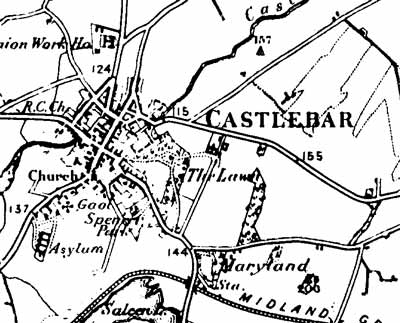|
ORDNANCE SURVEY LETTERS,
MAYO, edited
with an introduction by Michael Herity MRIA, will be launched by Dr. Séamus
Caulfield in the National Museum of Ireland – Country Life, Turlough Park,
Castlebar on Tuesday 23 June at 6.30pm.
The Ordnance Survey Letters are regarded as the best source for local
history in Ireland. These reports were written from the field mainly by John
O’Donovan, an exceptionally gifted scholar born on a small farm at Slieverue in
south Kilkenny, and the unsung Thomas O’Connor, a young hedge schoolmaster from
near Carrickmacross in Monaghan. They were written in the evenings after long
walks through the countryside searching out and questioning informants capable
of giving authentic and accurate information about the original Irish forms and
meanings of townland names and local antiquities.

An Old Ordnance Survey Map of Castlebar
|
The recommended spellings of place names were entered in Name Books,
civil Parish by civil Parish. From these they were copied at the headquarters of
the Ordnance Survey in the Phoenix Park by the 60 engravers who made the copper
plates from which the first edition of the six-inch maps were printed.
These Letters were comprehensive, covering 29 of the 32 counties of
Ireland (the exceptions are Antrim
and Tyrone, the maps of which were printed before the idea of sending O’Donovan
into the field was thought of, and Cork, the largest county and last to be
mapped). They were written between 1834 and 1841, well before the Great Famine
destroyed so many of our traditions.
The fifty copies of these Letters reproduced in typescript by Fr.
Michael O’Flanagan in the late 1920s are now mainly in our County Libraries. The
present printed edition, limited in number and edited direct from the original
Manuscripts, which are now in the Royal Irish Academy, distinguishes between the
contributions of the various authors and authorities, particularly between the
material written in the field and material copied by scriveners from older
printed and manuscript sources and edited with scissors-and-paste into the
Letters.
Mayo volume
One set of most interesting material in the present Mayo volume is
the stories written for O’Donovan by Hennelly, the hedge schoolmaster of
Ballintober Abbey, in which quotations in Irish are written in phonetic English
script.
John O’Donovan began work at Ballina in Co. Mayo with his colleague,
Thomas O’Conor, in the week beginning May 6th, 1838. On Saturday, May 12th, he
wrote the first of 70 letters to Thomas Larcom, Superintendent at the
headquarters of the Survey in Dublin, reporting on their first sortie into
Tirawley, where St. Patrick had built a square earthen church of clay for want
of wood.
O’Donovan continued in Killala and Rathfran, while O’Conor went first
east to the O’Dowda country of Killgarvan and Attymas, then west to
Cross-Patrick, Kilcummin, the tribal centre at Mullafarry, and finally Dún
Briste, where he quoted at length from McParlan’s Statistical Survey of the
county.
On May 25th, O’Donovan parted company with O’Conor to visit on the
Mullet peninsula ‘the celebrated father Lyons’, who had promised him every
assistance. As well as assuring him congenial company in comfortable quarters,
this enabled O’Donovan to see and report briefly on the Promontory Fort with
chevaux-de-Frise of Dunnamoe, to visit Brendan’s hermitage on the island of
Inishglora and to record the results of Dean Lyons’s investigations on the
Inishkeas. He also took down the story of Deodruisg and Dún Briste at Lyons’s
dictation in the local Irish dialect.
O’Conor moved south from Ballycastle past Nephin via Foxford,
Swinford, Ballaghaderreen, Claremorris, Ballyhaunis and Castlebar, while
O’Donovan took the western route south to Westport and Ballinrobe. They met at
last at Ballinrobe on August 10th, where, having compared notes, O’Donovan wrote
an essay of over 100 pages on the ancient territories of the county. They wrote
up their reports on Mayo at Tuam in late August before moving on to begin work
in Galway.
Professor
Emeritus Michael Herity, MRIA, taught Archaeology at UCD for over 30 years. He
has edited 9 volumes of the Ordnance Survey Letters, the prime source for Irish
local history, in retirement and plans to complete the province of Connacht this
year.
ORDNANCE
SURVEY LETTERS, MAYO can be purchased from the
Museum shop, National Museum of Ireland – Country Life, Turlough Park,
Castlebar, Co. Mayo
|